Update NDA for the new Trade Secrets Act (DTSA)
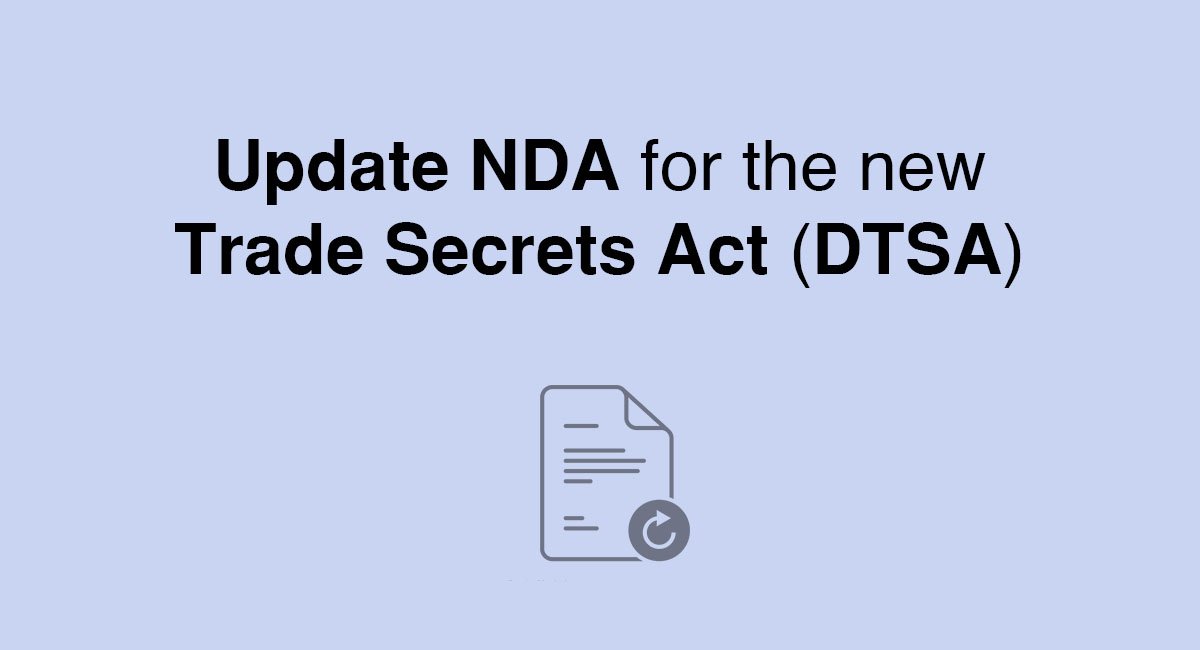
A non-disclosure agreement (NDA) is one of the most common tools that businesses, entrepreneurs, companies, startups and employers use to protect confidential information including trade secrets.
Trade secrets can be the lifeblood of a business. Famous trade secrets include Google’s search algorithm, KFC’s secret spice and WD-40’s formula.
Unlike patents, trade secrets do not have to be registered or recorded anywhere so in theory, if protected carefully, a trade secret can last indefinitely.
To qualify as a trade secret, the information must be kept confidential from the public, provide inherent commercial advantage to the owner due to its secrecy and the owner must take reasonable steps to protect the secret.
Steps that would be considered reasonable enough to protect a trade secret can include labelling trade secrets as “Trade Secret” or “Confidential“, restricting general personnel access to the information, keeping the information in a locked safe and using non-disclosure agreements for personnel, contractors and other third parties that have access to the information.
Any confidential information that qualifies as a trade secret receives protection under common law and most US state law that have adopted the Uniform Trade Secrets Act (UTSA).
Contents
Defend Trade Secrets Act 2016 (DTSA)
However, a new federal enactment Defend Trade Secrets Act 2016 (DTSA) will enable applicants to file a civil suit for protection of their trade secrets under federal law besides the UTSA and common law.
This is significant. Prior to the DTSA, aggrieved parties (“the applicant”) who believe that their trade secrets had been stolen or misused by other parties (“other party”) could only file a suit under state or common law (48 states except New York and Massachusetts have adopted some form of the UTSA).
This was unlike patent, trademark and copyright claims which could be pursued in the federal court.
However, the DTSA is not going to pre-empt the UTSA. This means that applicants still have the choice of whether to sue under the UTSA or under the new DTSA.
Under the DTSA, a trade secret includes information in any form:
whether tangible or intangible, and whether or how stored, compiled, or memorialized physically, electronically, graphically, photographically, or in writing.
This suggests that the information could include information stored in a person’s memory.
Contrast this with the definition of a trade secret under the UTSA which is:
information, including any formula, pattern, compilation, program, device or process, which derives independent value from not being generally known and is the subject of reasonable efforts to maintain its secrecy.
From this initial reading, it would seem that the DTSA accepts a broader definition of what would constitute a trade secret.
The DTSA will also provide for extra monetary damages and injunctive relief including the ability to apply for “ex parte” property seizures for wrongful use of trade secrets without notice to the offending party.
“Ex parte” is a Latin term that refers to an application by and for the benefit of one party. An ex parte order then basically refers to an order that is granted by the court, without notice to the other party.
Misappropriation of Trade Secret
To be able to make a claim under the DTSA, the applicant must prove that there has been “misappropriation” by the other party against whom an order is sought.
Misappropriation roughly encompasses either of the following:
- The acquisition of a trade secret by the other party who knows or has reason to know that the trade secret was acquired by improper means.
- The other party intends to disclose or use the trade secret, whether he or she knows that the information is a trade secret.
- The other party intends to disclose or use a trade secret that he or she does not know was obtained through improper means.
Here’s the full text of the relevant sections in the DTSA defining the term “misappropriation”:
- First section
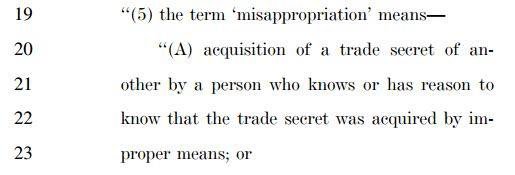
- Second section:
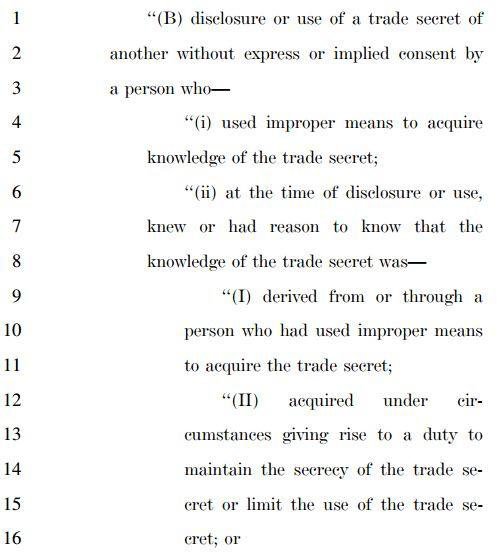
- Third section:
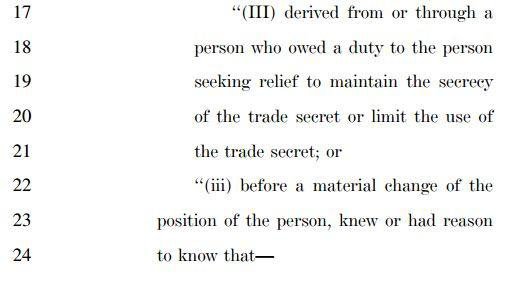
- Fourth section:
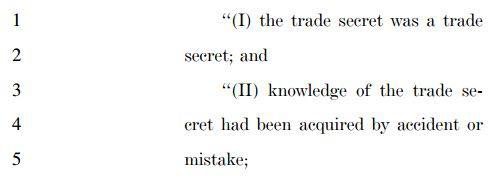
The term “improper means” includes “theft, bribery, misrepresentation, breach…” of a duty to maintain secrecy. However, this does not include “reverse engineering or independent derivation“.
This means that if the other party has been able to successfully reverse engineer a trade secret or independently worked out the trade secret on his or her own, he or she would not be guilty of misappropriation.
Ex parte order
If the other party was found to be guilty of misappropriation, one of the biggest changes under the DTSA is the introduction of the right to apply for an ex parte order to seize property in “extraordinary circumstances” in order to “prevent the propagation or dissemination of the trade secret that is the subject of the action.”
Although there are several distinct restrictions that must be met before the court will issue an ex parte order, this new power can be controversial as there’s potential for abuse by applicants.
These are the restrictions that must be met before a federal court can issue an ex parte order:
- A temporary restraining order must be inadequate because the other party would evade, avoid or otherwise not comply with such an order.
- An immediate and irreparable injury would occur without the order.
- The harm to the applicant outweighs the harm to the other party and also substantially outweighs any harm to third parties.
- The applicant will be able to prove that the other party has in his or her possession the trade secret and has misappropriated it or will misuse it.
- The applicant describes with reasonable specificity the trade secret to be seized and to the extent reasonable under the circumstances, is able to identify the location where it is.
- If notified, the other party would destroy, move, hide or otherwise make the trade secret inaccessible.
- The applicant has not published the requested seizure.
To prevent abuse of the ex parte process by applicants, the DTSA states that the applicant has the burden of proof for the order, must post security and is not entitled to make any copies of the seized information.
A hearing must also be held within seven days of the ex parte order to determine if the facts truly warrant the continued upholding of the ex parte order. If not, the order will be modified.
If subsequently, it is found that the applicant was wrong in his or her request for the seizure, the applicant can be subject to a claim for damages by the other party including for “lost profits, cost of materials, loss of good-will, punitive damages” where the seizure was sought in bad faith and a reasonable attorney’s fee, similar to the relief provided in § 34(d)(11) of the Trademark Act of 1946.
There’s also a required immunity provision in the DTSA that protects whistleblowing employees from any civil or criminal lawsuit if they were to disclose trade secrets in relation to the reporting of a violation of the law to a government official or attorney.
This includes protection from any legal retaliation by any employer against a whistle-blowing employee.
Differences between UTSA and DTSA
If you’re wondering whether you should use the UTSA or DTSA to protect your trade secrets, here’s a summary of the main practical differences between filing a suit under the UTSA or the DTSA:
- The definition of what constitutes a trade secret under the DTSA is likely to be broader than under the UTSA.
- Under the DTSA, you can file a claim in the federal court instead of relying only on state law or common law.
- The DTSA allows you to apply for an ex parte seizure order if you fulfil certain requirements and this can be highly effective in stopping any damaging publications or misuse.
- The DTSA awards up to three times the damages suffered compared to the UTSA that only awards up to two times the damages suffered.
- The DTSA expressly protects whistleblowing employees including contractors and consultants if a disclosure was made to a government official or attorney for the purpose of reporting a legal violation.
- The statute of limitation for an application for UTSA is three years while it is five years under the DTSA.
As a business owner you need to decide what law you’re most likely to prefer using as protection for your trade secrets. We know that the inherent value of a trade secret is in its maintained secrecy and once exposed, monetary damages may be insufficient to cover the loss of potential profit.
This is especially true if you’re counting on future profit whose value has yet to be proven in the market.
For this reason, the DTSA currently comes across as a law that provides you with more injunctive relief remedy, especially because in theory, it provides you with the ability to apply for an ex parte order.
Not to mention that the damages offered under the DTSA are higher than under the UTSA. If you believe that it is time that you switched over to the DTSA, you need to ensure that any non-disclosure or confidentiality agreements that you draft will be covered under the DTSA.
To do so, you need to ensure that you include the required immunity provision under the DTSA for whistleblowers in any of your NDA agreements that govern the use of a trade secret or other confidential information.
You can include the entire provision itself directly in your non-disclosure or confidentiality agreements or just include a cross-reference to a separate policy that you have drafted that includes that provision.
Here’s the required immunity text as provided in the DTSA act itself:
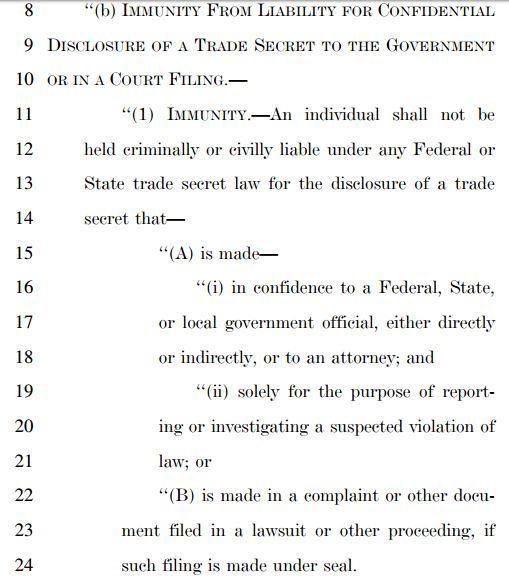
And:
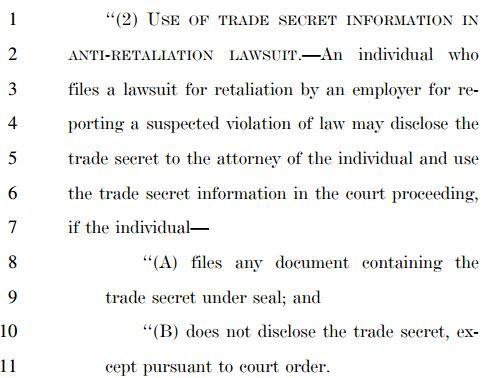
For an example of an actual provision that you could use in your non-disclosure agreements, here’s one taken from Latham & Watkins LLP:

Review all your internal NDA agreements signed (or the ones you plan to sign) and check if you need include the immunity clause as required by the DTSA.
In addition, just like with any ordinary NDA agreement that you do draft, you want to make sure that your agreement complies with existing important requirements such as ensuring that it’s not unnecessarily broad nor unreasonable in its scope and definitions as evidenced in the case of Lasership, Inc. v. Watson where the court held that the agreement was unenforceable because the requirement of confidentiality applied too broadly.
Credits: Icon Reload Document by Kid A from the Noun Project.
Jan 30, 2017 | Non-disclosure Agreements
This article is not a substitute for professional legal advice. This article does not create an attorney-client relationship, nor is it a solicitation to offer legal advice.